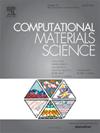Structural and mechanical properties of W-Cu compounds characterized by a neural-network-based potential
IF 3.1
3区 材料科学
Q2 MATERIALS SCIENCE, MULTIDISCIPLINARY
引用次数: 0
Abstract
We develop a neural-network deep potential (DP) model spanning 0–3,000 K and 0–10 GPa, trained on density functional theory data across the full concentration CuxW100-x compounds. We systematically investigate the structural and mechanical properties of W-Cu alloys. The results show that the bulk modulus (B) and Young’s modulus (E) of W-Cu alloys exhibit a linear decline as the Cu content increases, indicating a softening trend in the CuxW100-x compounds as the Cu concentration rises. Besides, a brittle-to-ductile transition in the deformation mode predicted is predicted at around 37.5 at. % Cu content. Moreover, tensile testing demonstrates that Cu-poor region effectively block shear band advancement, simultaneously stimulating nucleation of secondary shear bands in adjacent Cu-rich domains. The results are anticipated to aid in exploring the physical mechanisms underlying the complex phenomena of W-Cu systems.

基于神经网络电位表征的钨铜化合物的结构和力学性能
我们开发了一个神经网络深度电位(DP)模型,跨越0-3,000 K和0-10 GPa,在全浓度CuxW100-x化合物的密度泛函理论数据上进行训练。系统地研究了钨铜合金的组织和力学性能。结果表明:随着Cu含量的增加,W-Cu合金的体积模量(B)和杨氏模量(E)呈线性下降趋势,表明随着Cu浓度的增加,CuxW100-x合金呈现软化趋势;此外,在预测的变形模式中,脆性到延性的转变预计在37.5 at左右。% Cu含量。此外,拉伸试验表明,贫cu区有效地阻断了剪切带的推进,同时刺激了邻近富cu区的次级剪切带的成核。这些结果有望有助于探索W-Cu体系复杂现象背后的物理机制。
本文章由计算机程序翻译,如有差异,请以英文原文为准。
求助全文
约1分钟内获得全文
求助全文
来源期刊

Computational Materials Science
工程技术-材料科学:综合
CiteScore
6.50
自引率
6.10%
发文量
665
审稿时长
26 days
期刊介绍:
The goal of Computational Materials Science is to report on results that provide new or unique insights into, or significantly expand our understanding of, the properties of materials or phenomena associated with their design, synthesis, processing, characterization, and utilization. To be relevant to the journal, the results should be applied or applicable to specific material systems that are discussed within the submission.
 求助内容:
求助内容: 应助结果提醒方式:
应助结果提醒方式:


